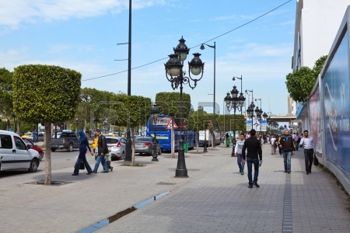T is for topiary: the 1st of three ‘T’s that define modern Tunisia
Click here and take a good look at the photograph of the spiral-shaped tree in the picturesque village of Sidi Bou Said, on the fringes of the Tunisian capital Tunis. The photo is by one Patrick Costello, who’s apparently from Portsmouth, England. He took it in March 2014, perhaps while on holiday in Tunisia. Sidi Bou Said is very popular with tourists.
But that tree and its carefully controlled shape is not as unusual in Tunisia as you might think. There might be trash on some of the streets of Tunis, but the trees are carefully coiffured. Up at the top is another photo (not Mr Costello’s but from elsewhere) of that Sidi Bou Said tree.
Most neighbourhoods have rows of beautifully shaped trees. Some avenues are green, shaded archways of trees that have been impeccably trained to meet and interleave branches.
Head out of Tunis to the countryside and lines of immaculately shaped, topped and manicured trees stretch out along the highways.
There is a decided love for topiary in Tunisia, perhaps an early consequence of its Roman experience for it was a contemporary of Julius Caesar’s that Pliny’s Historia Naturalis credits with introducing these elaborate living sculptures to Roman gardens.
But might Tunisia’s interest in topiary go back even further?
A piece in The Smithsonian magazine, which lists five of the world’s most fascinating topiary gardens, adds another fascinating dimension to the concept of painstakingly clipped living ornamentation. Michele Lent Hirsch ponders “who should get the real credit for these horticultural feats” and concludes that it might really be ancient slaves. She quotes historian George Drower’s book Garden Heroes and Villains to explain that slaves did the gardening work in Rome, arriving there, of course, from elsewhere – Greece, Syria and Egypt. So they “might have introduced topiary from other lands,” Ms Hirsch writes, “perhaps from Persia where the army of Alexander the Great had found hedges of clipped myrtle.”
If this is true, she suggests, the art of topiary may go back even further in time than 38 BC.
It’s not clear when Tunisia fell in love with topiary but it clearly remains a modern passion.
(Tomorrow: …and ‘T’ is for tiles: the three ‘T’s that define the mosaic of Tunisia)


